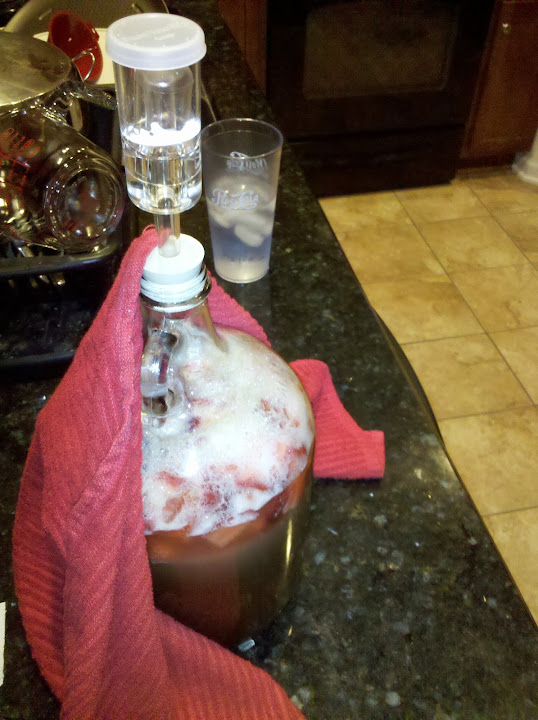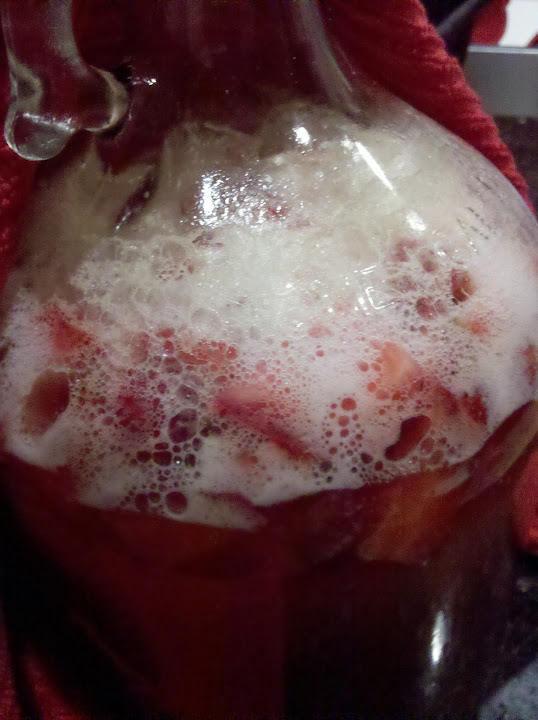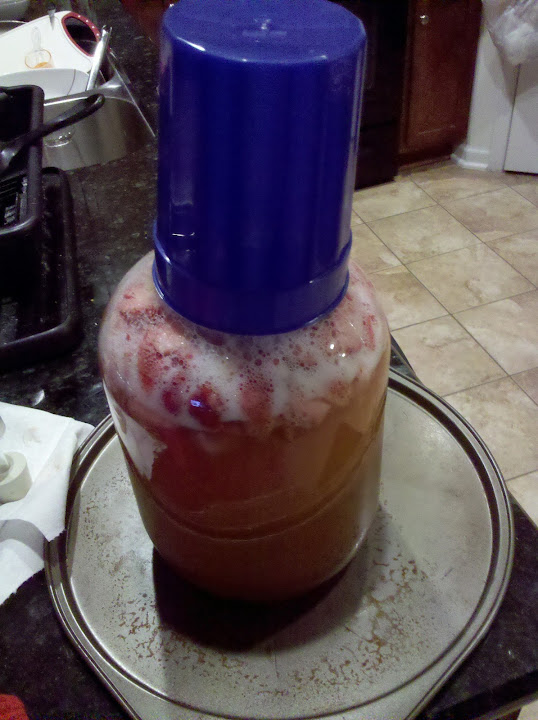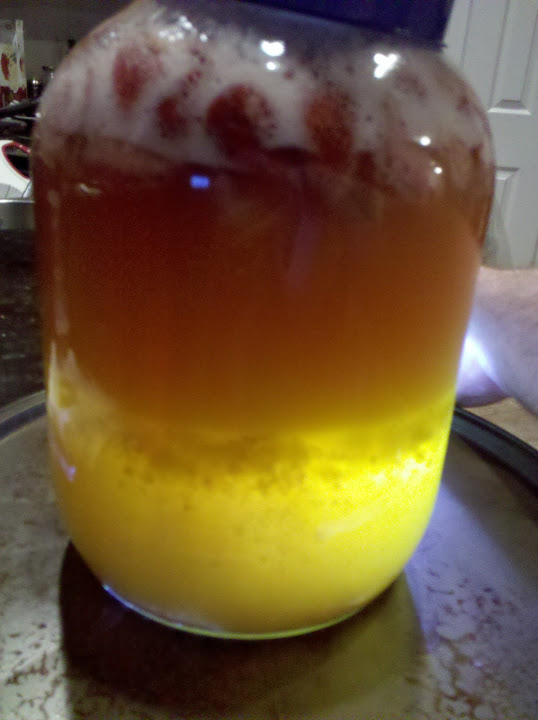As I may have mentioned in a previous post, I have been interested in trying to create a strawberry mead. Although I supposed that technically it should be called a “melomel” as a melomel is a mead with fruit added in any form from fresh to dried to juice. This past Easter I got my wish of 2 pounds of strawberries from my wonderful wife and I decided to give it a shot.
Experiment #2 is a 1 gallon melomel using:
- 3 lbs. of orange blossom honey
- 2 lbs. of cut slightly sugared strawberries
- around 3/4 gallon boiled water to fill
- Lalvin D47 yeast
- 1 tsp. of yeast nutrient
Once again I bought everything I needed except the water and strawberries from American Brewmaster. I also picked up another airlock, since I only had 1 to begin with but 2 jugs, and this time I decided to go with the 3 piece instead of the S type airlock as you’ll notice in the pictures. All in all I spent $25.00 for the ingredients minus strawberries and airlock.
The overall process went like this:
- Boil a gallon and a half of water for 15 minutes.
- Add honey to jug
- get yeast activated
- Cut up strawberries while waiting for water to boil
- Occasionally QC strawberries for tartness
- Add a very small amount of granulated sugar to start pulling out the strawberry juices and sweeten them. I used maybe 3/4ths of a tablespoon and hand tossed them.
- Cool boiled water and then add to jug (you don’t want your jug exploding on you do you?)
- Shake for 5 minutes (I don’t know how my arms didn’t physically detach from my body and run away screaming).
- add yeast nutrient and strawberries and mix well
- Pitch yeast and mix a little bit
- Airlock and wait
The result was this:

Within an hour the airlock was bubbling nicely around 20 seconds per bubble (this has since dropped to as low as a bubble every second to 5 seconds). Within a couple of hours I noticed this:

I know that there was some foam that was there from the beginning due to all the shaking of the must but… it couldn’t be… kr…kr…krausen!? I anxiously crossed my fingers in hope that it would stop before it got to the airlock. For those that don’t know, krausen is the technical term for the foam that forms at the top during fermentations. Sometimes this foam can be little to none like shown in my previous experiment or it can come crashing through your airlock like the Terminator coming after the un-lucky Connor family. This foam is completely normal and nothing to really worry about unless it’s wearing sunglasses, totes a shotgun, and has a jaw sharper than a katana.
My situation was unfortunately the later. The foam came seeking air, getting in my airlock despite my best suctioning efforts with a sanitized turkey baster. Around 3AM when I realized the foam would not cease, nor desist, I decided to improvise and cut a hole in the bottom of a plastic cup, stick it over the top of the jug and cover the top of the cup with saran wrap. It should keep anything out but still let the foam escape. This worked and I thought the foaming was finished so I threw away the plastic cup the next day and to my horror it wasn’t done foaming and that was my last plastic cup I threw away. On top of this it was now Sunday night and any store I could use to make a blowoff setup was now closed. My improvisation this time around was just to take a cup and put it upside down over the mouth of the jug to keep stuff out.

Men, and women, I highly suggest if you are dealing with krausen that’s going to be running down the side of your equipment to place something under said equipment to help ease with cleanup after the foaming stops or you finally get your blowoff set up. I used a baking sheet and that helped keep the counters nice and clean instead of annoyingly sticky after the fact.
For those that haven’t seen a melomel, and maybe it’s just because it’s a strawberry melomel but I doubt it, during the initial portion of fermentation it’s not exactly the prettiest gal at the dance.

And it only got more “yucky” looking as time went on with weird floating tendrils and “gunk” floating around in the bottom section. Eventually this all settled down and the fermenting mixture became so opaque you can hardly see a light shining into it from the other side.
Now my mead… er… melomel is known to be fermenting strongly and I seriously need to set up a blowoff.
A blowoff is simply an airlock on steroids in a sense. Instead of a nice compact little piece that fits in the top of a drilled stopper, it’s a hose that feeds from the top of the fermenter into another container that has a layer of sanitized liquid or vodka in the bottom of it to prevent air from getting sucked back into the fermenter. I looked around on the wonderful internet and noticed an idea for an easy blowoff setup where the only thing I was lacking was a hose.

The idea as you can see in the picture is to take your 3 piece airlock, take the cap and float out of it and fit a tube over the inner tube of the airlock and then run that newly hooked on tube into the 2nd container with sanitized liquid. Again I went to the good fellas down at American Brewmaster and told them my problem, how I wanted to solve it, and the gentlemen knew exactly what I was talking about and cut me off a 2’ piece of hose. The ID (Inner diameter) fit PERFECTLY over the inner tube of my 3 piece airlock and looks like it’s probably about a 1/2” ID. I’m probably completely off on this but that’s what it looks like to me (I think this is one of those cases where size does matter).
Now with my blowoff setup, the melomel was free to foam to its hearts content which it obviously didn’t HAVE a heart because it was hell bent on keeping me from sleeping soundly. It never foamed into the 2nd container but it did manage to get a good ways up the tube. Once the foaming stopped, I just filled the airlock up with some sanitized liquid (up to the appropriate mark to use it as an airlock), pulled the tube off, put the float and cap back on, and have been letting it ferment soundly since then. The strawberries are losing color which is to be expected so I will probably look into racking it out of this jug and into another one in the next week or so.
At that point my plan is to let it ferment in a secondary for a month or so and then rack into a tertiary onto some fresh strawberries, blueberries, and maybe some clover honey to help bring the melomel back to the sweeter side of things and also bring back some of the fruit taste, and then let it age for a couple of months after removing it from the fruit again.
By the way, I did finally open that bottle of semi-sweet traditional mead from Starrlight Mead but seeing how long this post is already I will fit it in either during the week or as the topic for next weeks post.
Until next time,
Be well and thanks for all the fish!






